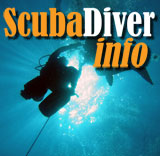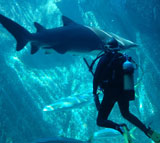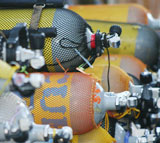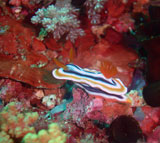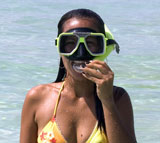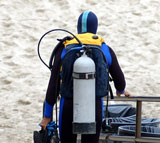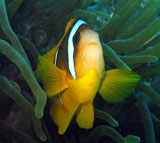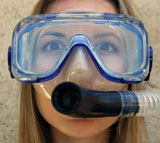Sea creatures
by Carol Cotton
Since the beginning of time there have been creatures living in the waters of our planet. Because of the many changes along the way, quite a few of those critters became extinct. By the looks of some of the fossils I've pulled out of a few rivers, I'm glad some of them don't exist anymore! Teeth of a Megalodon with estimates that the creature was 35 feet long, the massive inner ear bones of whales, a femur of a Saber Tooth Cat, a pre-molar of a Mastodon that covers the palm of my hand, enormous jawbones, and a whole lot more! Needless to say, I believe our waters are way safer to dive in now than they would have been millions of years ago!
Marine critters range in size from microscopic organisms to well over 40 feet in length. The food chain seems to begin with tiny plankton, and I find it quite ironic that a whale shark 40+ feet long thrives on it, as do Blue whales while are even larger that that!
The underwater world is still so foreign to us. Everything down there must be treated with kindness and respect. As divers, we must do our best to always be very aware of your surroundings at all times, and try to not touch anything while we're underwater. Coral is quite fragile, yet often very brittle and abrasive. However, if you touch it and break through its protective mucous-like barrier, bacteria and other foreign material can break through and actually kill the coral.
I have been scuba diving many places on this planet, and one thing that I enjoy is the different critters I have seen at different places. Take
Porcupine puffers, for example. The first ones I ever saw were in the waters surrounding the Bahamas and they were well over 15 inches in length. Two weeks later I saw some in Bonaire and they might have been half that size! You will see completely different fish in the Caribbean than you will in the South Pacific, or even in the Atlantic! Diving the Galapagos Islands will give you a true feel for evolution and how animals adapt and change.
Okay, so let's begin with the ...
fun creatures
Dolphins -- You don't often see dolphins while diving. If you do, they usually dart in and out and don't hang around. Some lucky divers may catch the interest of a dolphin and the animal may then show off or play.
Sea Lions, Harbor Seals, Stingrays, Spotted Eagle rays, and Giant manta rays to name a few! -- I mention all of these large animals for a reason. I have had incredible experiences with all of them at one time or another. I have been fortunate enough to have numerous awesome encounters with giant manta rays! Seals can be endless fun as they are endlessly curious and love to pose and explore.
Manatees -- are large herbivorous mammals that seem like a water-based cross between cows and elephants. They have smallish flippers that have bones that feel like arms and fingers. Their faces and tails look unlike those on any other animal. They sleep a lot, come up for air every few minutes (and less often when they sleep). They seek out the Florida river areas during the winter time. The average adult is about ten feet long and weighs about a thousand pounds. There are laws on what you can and cannot do when snorkeling with manatees. They can be absorbed in their own thing (mostly eating and sleeping) or they can be quite playful and seek human contact. I shot the picture of the one below at Three Sister in Crystal Springs, Florida.
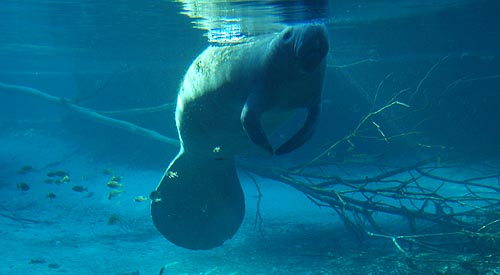
Reef fish -- vary in size, color, shape and temperament. It has been my experience that each fish is as individual as we are. They all have their own personalities, too! Some are shy, some are outgoing, some are nocturnal, and some prefer daylight hours.
Among the most entertaining ones are parrotfish. They got their name from a funny looking set of teeth that looks like a parrot beak. If the name weren't already taken, they should be named clownfish as they are a hoot to watch. They have this goofy grin on their faces and are constantly buzzing around, clowning and harrassing other fish. You could spend a whole dive just watching one of those fellows. They have funny habits, too: parrotfish munch on corals and poop out sand! There are almost a hundred species of parrotfish. The ones in tropical waters are usually between a foot and two long.
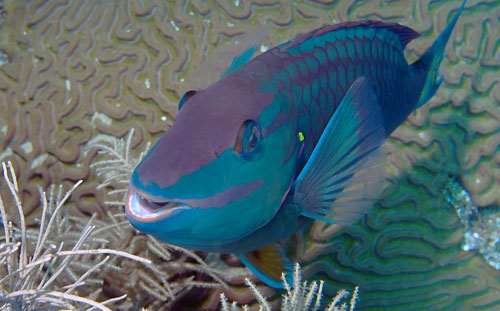
Another funny critter is the yellowhead jawfish. Although they are fish, those little guys have holes in the ground from which they cautiously emerge, being vertical in the water. Get too close and they retract into their holes, backwards, at lightening speeds. I don't know how they can go backward that fast!
Certain creatures prefer to be alone while some prefer to swim in schools or pods. Some creatures are born, grow up, live, and die all within a very small area! Some migrate, just as birds do. Some are nurtured by their mother for varying amounts of time, whereas some hatch and never have any contact with either parent! In some rare cases some are even carried around in a their
father's pouch until they are ready to be born!
And now the ...
animals to avoid
I have come in contact with thousands of varieties of underwater creatures, many in multiples or even hundreds at once. I have experienced swimming through hundreds of jellies to hundreds of hammerhead sharks. It has been my experience that most animals are afraid of things they don't understand. And I'm yet to meet a shark that understands scuba! The bubbles and the sounds scuba equipment make keep a lot of animals away. Oh, and yes, I do still have all of my original parts! So there!
How to know the difference.
NAUI designed an informative slide for the beginning scuba class learning materials. Hazardous creatures were divided into five categories. I will address each of these categories below:
Snappers
Sharks and Eels --
Both have a keen sense of smell. Sharks see very well, but eels don't. Sharks can be seen anytime, whereas eels are primarily nocturnal. It's best to stay away from the end of both that has teeth! Below you see a spotted eel I saw off Little Cayman in the fall of 2006. Eels actually look more menacing than they are, but it's still a good idea to stay clear of those sharp teeth.
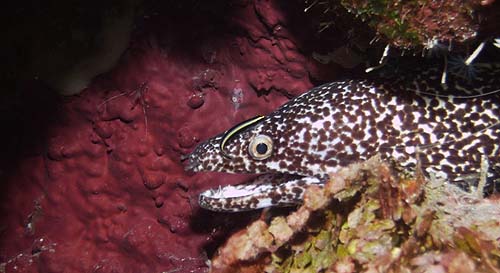
Sharks are the ultimate predators of the sea. But while they are predators, they are not mindless killers to be feared and hunted down. Studying sharks can be a thrilling experience, and shark tours are all the rage. But sharks are predators and must be treated with respect.
We photographed the 7-foot reef shark on a 2009 dive trip to Turks and Caicos. Reef sharks (as wel as nurse sharks) are relatively common in the more remote reef and wall dives, and they are rarely aggressive, but, again, treat the animals with respect.
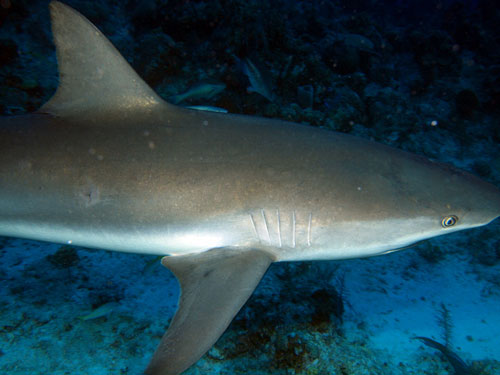
Ever since the movie "Jaws," great white sharks have had the ultimate bad reputation. Well, they are certainly capable of doing damage. Here are some Great White facts: They are actually black and only the underside is white. They hunt by day, have very good vision and hunt prey such as sea lions, elephant seals (and at times surfboards) with caution and a plan. Females can be 20 feet long and weigh 5,000 pounds. For some reason, most attacks are during high tide. There are about 370 different specials of sharks, but only four of them are warm-blooded, among them the great whites. They are all individuals with personalities and quirks. Tagged great whites have been spotted at depths of almost 2,500 feet. Like hibernating animals, they fatten themselves up during feeding season, then return o their feeding grounds much thinner. They have been around in the current form about 11 million years. They've been known to lose a fight against orcas. Their teeth are embedded in cartilage and not bone, and they lose thousands over their still unknown lifetime. While the telltale dorsal fin is the trademark of a shark sighting, they can actually leap out of the water.
Stickers
Sea Urchins --
These critters certainly aren't what I'd classify as an attack animal, yet
they can be a real pain. They hang out on the ocean floor and in cracks and crevasses in the coral looking for food.
Problem is if you touch one or step on one, its spines penetrate the skin
and break off. They are almost impossible to remove and easily become
infected. Stay clear of them! There are actually commercial divers who collect sea urchins as they are a prized delicacy in some Asian markets.
Scrapers
Coral --
Again, these are not attack creatures. They are stationery on the ocean floor or attached to objects underwater. The reason they are considered to be scrapers is because of how abrasive they are when you brush up against them. This is another good reason to be aware of where you are underwater at all times!
Stingers
Stingrays --
Stingrays are rather docile creatures, really. It takes a lot to provoke them
and even then the reaction is defensive. I have heard of people getting stung by stingrays while walking along the beach. The stingray buries itself under the sand in search of a meal, and the unsuspecting person stepped on them. Stingrays have barbed tails with anywhere from one to six barbs.
The barbs have poison glands and can also easily cause infections. I have heard being stung by one is no fun! The pain is excruciating!
And Steve Irwin's freak, and deadly, accident will serve as a reminder that
even encounters with gentle animals can be fatal.
Shockers
Lionfish and Scorpion fish
are considered shockers, not because they shock you if provoked, but the after effect of the poison entering the person's bloodstream has signs and symptoms of shock; blank stare, dilated pupils, shallow breathing, and more. Lionfish are brilliantly marked and are highly visible, where scorpion fish are masters of disguise. They sit on the bottom or on ledges or on coral and blend in with their surroundings! All of these fish are rather territorial, so it's best to respect their privacy!
Below you can see a lionfish we photographed in August of 2009 at Turks and Caicos. Lionfish generally hide somewhere and don't move much, but don't let that fool you into trying to touch them! They are also considered an invasive species.

Cone Shells
are also hazardous. Seems a nasty little critter lives inside that beautiful shell and if he gets upset he has a barbed tail and isn't afraid to use it!
If you are interested in learning more about the different creatures you are likely to encounter, the Internet is always an excellent source. Several informative books are also available. My favorite is a series by Ned DeLoach, photographed by Paul Humann. In my collection I have Reef Fish Identification, Reef Coral Identification, Reef Creature Identification, Costal Fish Identification, Reef Fish -- Galapagos, and Reef Fish Behavior. Beautifully captured in photographs, each variety of fish is well described. Abbreviated versions are available for underwater use. They are titled Fish-In-A-Pocket series. Check out: www.fishid.com
|
